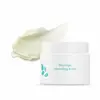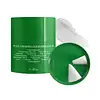What's inside
What's inside
 Key Ingredients
Key Ingredients

 Benefits
Benefits

 Concerns
Concerns

 Ingredients Side-by-side
Ingredients Side-by-side

Ethylhexyl Palmitate
EmollientCaprylic/Capric Triglyceride
MaskingSorbeth-30 Tetraoleate
EmulsifyingPolyethylene
AbrasivePEG-7 Glyceryl Cocoate
EmulsifyingParfum
MaskingGlyceryl Caprylate
EmollientEthylhexylglycerin
Skin ConditioningTocopheryl Acetate
AntioxidantBetula Platyphylla Japonica Juice
Skin ConditioningAnastatica Hierochuntica Extract
AstringentIris Versicolor Extract
EmollientMoringa Oleifera Seed Extract
Skin ConditioningPerilla Frutescens Leaf Extract
MaskingRhododendron Chrysanthum Leaf Extract
MaskingGlycerin
HumectantCarthamus Tinctorius Oleosomes
EmollientWater
Skin ConditioningSqualane
EmollientCetyl Ethylhexanoate
EmollientNeopentyl Glycol Diheptanoate
EmollientHydrogenated Phosphatidylcholine
EmulsifyingAlcohol
AntimicrobialHydrogenated Lecithin
EmulsifyingPolyglyceryl-10 Myristate
Skin ConditioningPolyglyceryl-10 Stearate
Skin Conditioning1,2-Hexanediol
Skin ConditioningCetearyl Alcohol
EmollientPolyglyceryl-2 Stearate
EmulsifyingStearic Acid
CleansingPanthenol
Skin ConditioningCarthamus Tinctorius Seed Oil
MaskingOenothera Biennis Oil
EmollientSodium Ascorbyl Phosphate
AntioxidantPolyquaternium-51
Skin ConditioningGlyceryl Arachidonate
EmollientGlyceryl Linolenate
EmollientBiotin
AntiseborrhoeicFolic Acid
Skin ConditioningPyridoxine
Skin ConditioningCyanocobalamin
Skin ConditioningEthylhexyl Palmitate, Caprylic/Capric Triglyceride, Sorbeth-30 Tetraoleate, Polyethylene, PEG-7 Glyceryl Cocoate, Parfum, Glyceryl Caprylate, Ethylhexylglycerin, Tocopheryl Acetate, Betula Platyphylla Japonica Juice, Anastatica Hierochuntica Extract, Iris Versicolor Extract, Moringa Oleifera Seed Extract, Perilla Frutescens Leaf Extract, Rhododendron Chrysanthum Leaf Extract, Glycerin, Carthamus Tinctorius Oleosomes, Water, Squalane, Cetyl Ethylhexanoate, Neopentyl Glycol Diheptanoate, Hydrogenated Phosphatidylcholine, Alcohol, Hydrogenated Lecithin, Polyglyceryl-10 Myristate, Polyglyceryl-10 Stearate, 1,2-Hexanediol, Cetearyl Alcohol, Polyglyceryl-2 Stearate, Stearic Acid, Panthenol, Carthamus Tinctorius Seed Oil, Oenothera Biennis Oil, Sodium Ascorbyl Phosphate, Polyquaternium-51, Glyceryl Arachidonate, Glyceryl Linolenate, Biotin, Folic Acid, Pyridoxine, Cyanocobalamin
 Reviews
Reviews

Ingredients Explained
These ingredients are found in both products.
Ingredients higher up in an ingredient list are typically present in a larger amount.
This ingredient is an emollient, solvent, and texture enhancer. It is considered a skin-softener by helping the skin prevent moisture loss.
It helps thicken a product's formula and makes it easier to spread by dissolving clumping compounds.
Caprylic Triglyceride is made by combining glycerin with coconut oil, forming a clear liquid.
While there is an assumption Caprylic Triglyceride can clog pores due to it being derived from coconut oil, there is no research supporting this.
Learn more about Caprylic/Capric TriglycerideCetyl Ethylhexanoate is an emollient ester. It comes from cetearyl alcohol and 2-ethylhexanoic acid.
Cetyl Ethylhexanoate is an emollient that adds a velvety feel to skin without being greasy or oily. Emollients help trap moisture into your skin, keeping your skin soft and hydrated.
Ethylhexylglycerin (we can't pronounce this either) is commonly used as a preservative and skin softener. It is derived from glyceryl.
You might see Ethylhexylglycerin often paired with other preservatives such as phenoxyethanol. Ethylhexylglycerin has been found to increase the effectiveness of these other preservatives.
Water. It's the most common cosmetic ingredient of all. You'll usually see it at the top of ingredient lists, meaning that it makes up the largest part of the product.
So why is it so popular? Water most often acts as a solvent - this means that it helps dissolve other ingredients into the formulation.
You'll also recognize water as that liquid we all need to stay alive. If you see this, drink a glass of water. Stay hydrated!
Learn more about Water